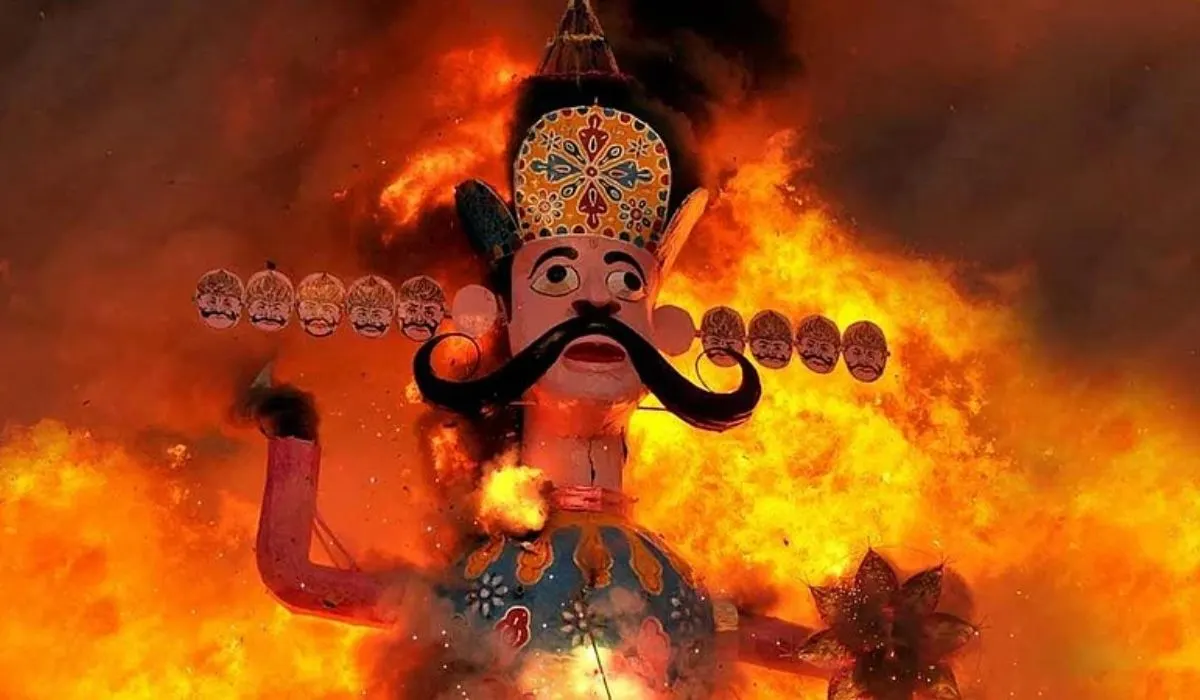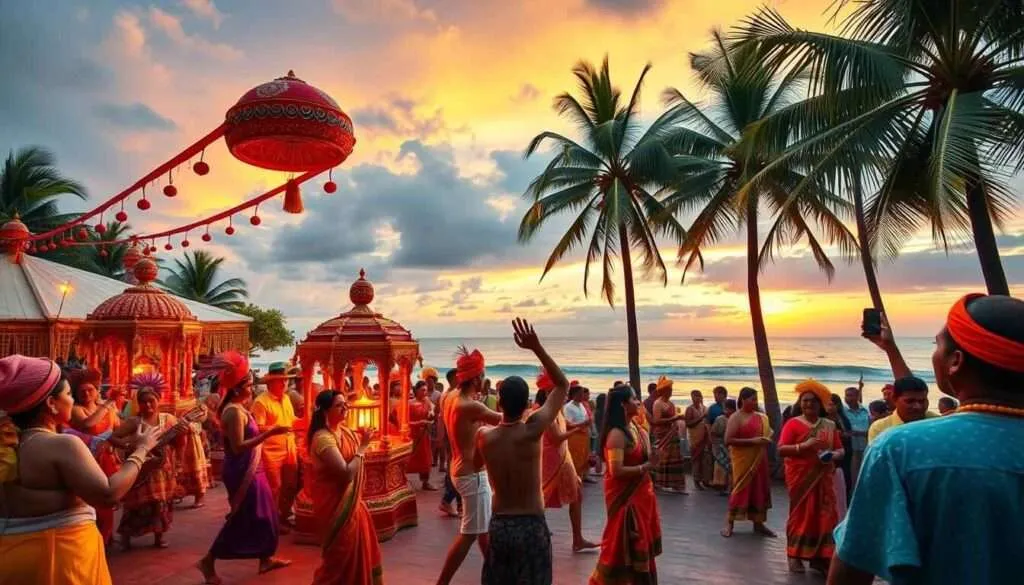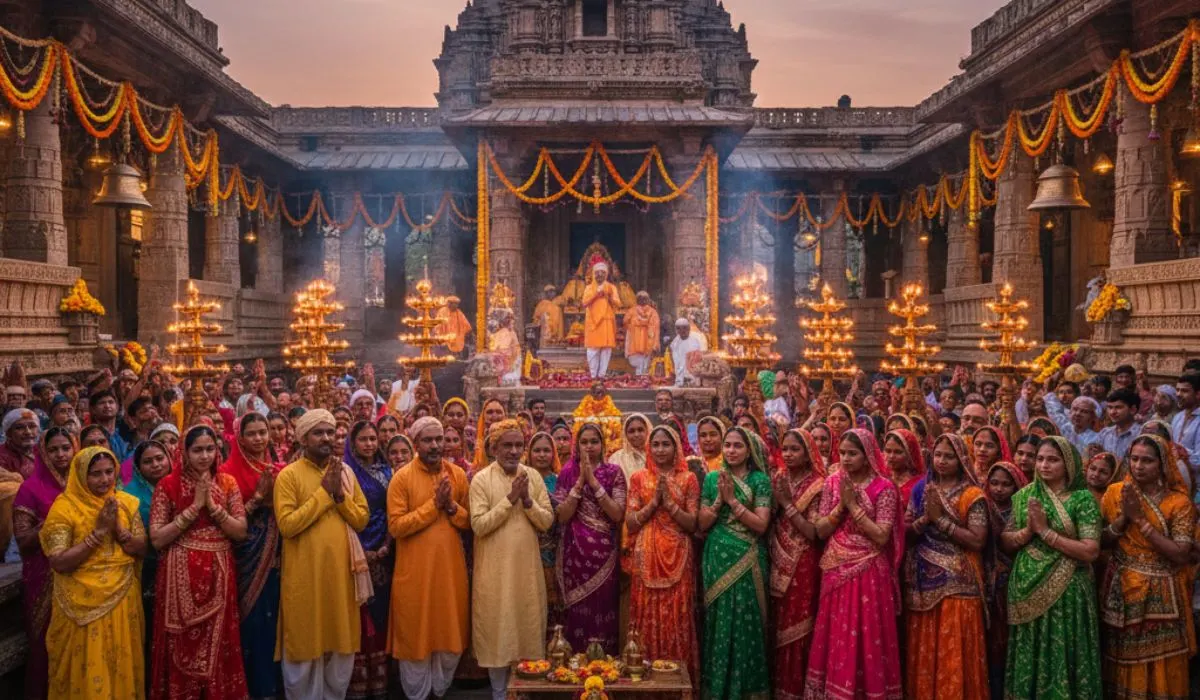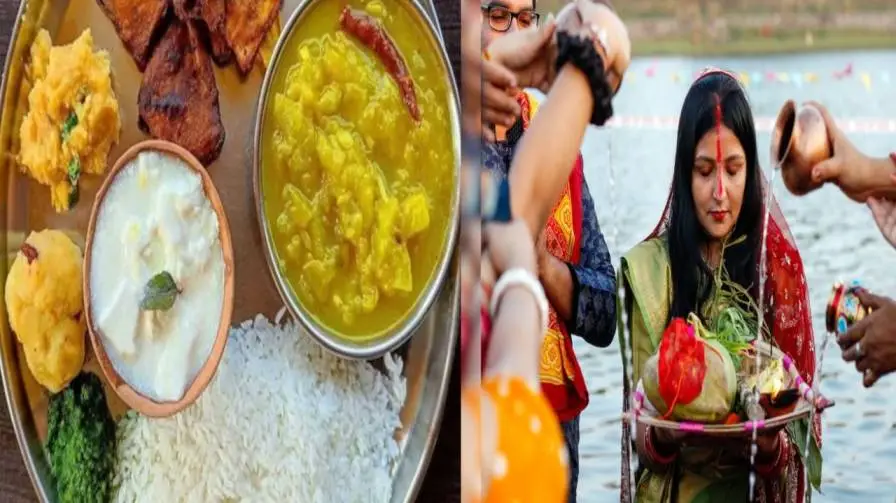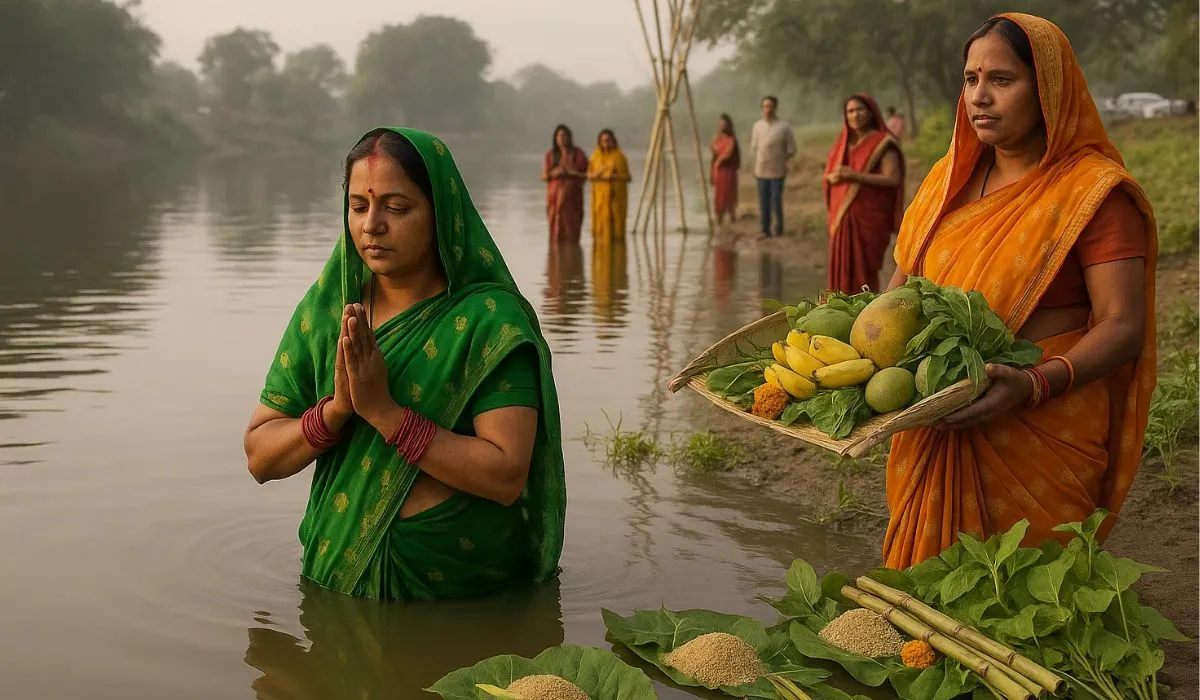Vijayadashami, or Dussehra as it is called in most parts of the world, is one of the most important festivals of India and it is a testament to the everlasting victory of good over evil. This festival is celebrated on the tenth day of a Hindu month known as Ashvina (which usually falls in the month of September-October) in honor of the triumph of Lord Rama over the demon king Ravana, as is told in the ancient epic Ramayana. Dussehra Celebrations in Bihar are strikingly varied, with giant effigy-burnings in the north of the country and the more female-centred Durga Puja in the east.
This Articled discusses the way in which Bihar gives this famous festival its own unique traditions, making it both universal and Bihari in the same breath.
History and Significance of Dussehra Celebrations in Bihar
Mythological Roots and Cultural Foundations
Dussehra is greatly tied to the ancient epic of Ramayana, which can be described as the tale of an epic battle of Lord Rama with the ten-headed demon king Ravana who had taken the wife of Rama, Sita. The victory of righteousness over wickedness is the final victory of Rama on this day according to the scripture. Even the name of the festival is based on the Sanskrit term dasha (ten) and hara (defeat), which refers to the defeat of the ten-faced Ravana.
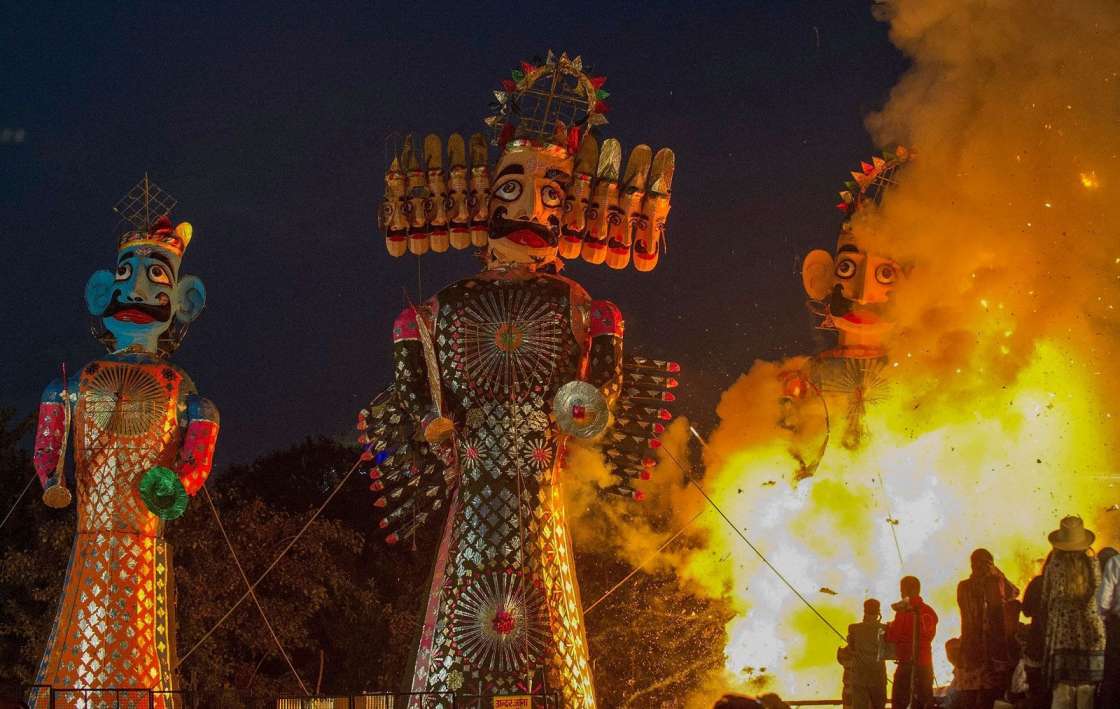
The Cultural Value of Dussehra Celebrations in Bihar
Dussehra Celebrations in Bihar culture is a complex event that does not just have a religious foundation:
- Agricultural Relationship: Dussehra of Bihar follows monsoon season and as such, it is associated with harvest completion, which further introduces dimensions of thanksgiving of harvest to the mythological festivals.
- A Community Bonding: The festival is an effective social glue that brings different people together, regardless of caste, classes and generational lines through similar rituals and celebrations.
- Moral Education: Dussehra Ramayana dramatic recitation offers an ethical teaching and moral lesson, with an emphasis on values like duty, honour and the ultimate triumph of the good.
Traditional Dussehra Celebrations in Bihar
Ramlila Performances
Bihar is not an exception as the Ramlila, or dramatic reenactment of the Ramayana, is the center of the Dussehra celebrations in the whole of North India. Such shows are very lively especially in the town and village settings all over the state where people gather to perform Fairs and Melas.
- Incomplete is Dussehra Celebrations in Bihar, without its colorful fairs (melas) which are sprung up in both city and country. These fairs are the spirit of the season of festivity and a space in which the community can celebrate other than the religious rituals.
- Patna Gandhi Maidan, one of the biggest Dussehra platforms attracts thousands of people who come to watch Ramlila and effigy burning.
- Local handicrafts, local foods and folk shows are also exhibited at regional fairs in Gaya, Muzaffarpur and Bhagalpur.
- Village melas are usually covered with agricultural shows that are in line with the harvest time where farmers display every best produce with traditional entertainment.
Local foods like litti chokha, balushahi and khad peda are also on the list of food specialties in these fairs along with the handicrafts specific to various areas in Bihar. The air is permeated with the folk sounds and the visuals of traditional performances, which gives the impression of carnival atmosphere, which promotes the celebratory mood of Dussehra.
Recomanded to read :- Why Dussehra Is a Major Festival in Ranchi?
Dussehra Celebrations in Bihar Cities and Villages
Patna Dussehra
Patna being the capital city of Bihar is the venue of some of the most magnificent and majestic Dussehra festivities in the state. The epicentre of the festival is the Gandhi Maidan, and weeks of preparations lead to the actual event. The Dussehra of Patna has the following characteristics:
- Ramlila performances which span several days, usually involving professional actors, and ornate sets.
- And huge effigies of Ravana, and Kumbhakarna, and Meghnath, above the maidan, and blazing with fireworks.
- Cultural events such as local artistes, dance troupes and musical performances during the days before Dussehra.
- Social involvement that unites the citizens of the whole city and beyond.
Gaya and Darbhanga
In addition to the capital, there are other cities in Bihar, with their own Dussehra:
Gaya, which is mostly associated with Pitru Paksh practices, also has colorful Dussehra festivals, which infuse the strong religious nature of the city into the festival practices. Here the focus is on the religious practices as well, and the elaborate Durga Puja pandals turn straight into Dussehra festivals.
Darbhanga in the north of Bihar presents the culture of the Mithila region on the Dussehra festival. The festivities here characterize the combination of Maithili culture, whereby, special folk songs and dances are sung and danced on during the festival. The royal history of the city gives the festivals a royal flavor, as there are processions and events, which show the aristocratic background of the city.
Rural Bihar Celebrations
When the big cities are a display of mass productions, the core of the Dussehra tradition in Bihar lies in its millions of villages, where festivals can be less elaborate, but are more often connected to regional traditions. Typically observances of rural Dussehra include:
- More participatory than perfection based Ramlila organized by the community.
- Others Folk songs and dances particular to Bihar.
- Pagan ceremonies which combine the agricultural thanksgiving with mythological elements.
- Local fairs, local handicrafts, games, and local delicacies.
Ayudha Puja and Occupational Rituals
Similar to most of South India, there are communities in Bihar, which practice Ayudha Puja during the ninth day of Navratri, ceremony devoted to the tools and instruments of their survival. This practice includes:
- Clearing and ornamentation of Plows and farm tools by farmers.
- Otherwise, researchers are completely baffled by the fact that workers do puja over their tools and equipment.
- Students venerating their books and other learning resources.
- Craftsmen cursing the tools of their work.
It is a ritual which recognises the divine nature of labour and thanks the source of livelihood. It shows the totality of the Hindu worship that is spiritually important in ordinary objects and processes.
Modern Dussehra Celebrations in Bihar
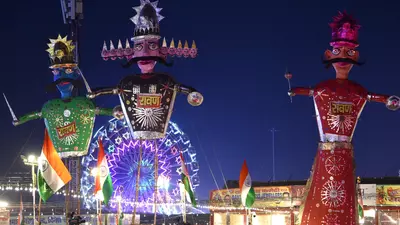
Eco-Friendly Initiatives
There has been a recent rise in awareness of the environmental effect of traditional Dussehra celebrations, and especially the lighting of effigies filled with firecrackers. This has resulted in a number of environmentally friendly inventions:
- Made of natural materials, without toxic chemicals, Green Ravana.
- Other celebrations that emphasized on cultural programs instead of burning effigies.
- Environmental awareness of greener celebrations in schools and communities.
- Recycling operations of materials that are used in pandals and decorations.
Although these transformations are rather slow, they still mark a significant shift in the traditions which preserve the spirit of the festival, but diminish ecological footprint.
Technology and Social Media
The celebration and experience of Dussehra has also changed in Bihar due to the modern technology:
- Led lights have most of the old bulbs in Ramlila stage and pandals changed into the new LED bulbs and given more visual impressions whilst saving more energy.
- Social media can be used to exchange events among communities as well as organize celebrations.
- Diaspora Biharis can join in major Ramlila performances through live streaming.
- Online payment systems allow giving donations to Ramlila committees and organizers of the festivals.
These technological incorporations have served to keep and propagate Dussehra traditions despite the modernization of the society so that they can be accessible to new generations with different lifestyles and priorities.
Challenges in Celebrating Dussehra Celebrations in Bihar
Logistics and Management
It becomes quite difficult to organize Dussehra festivities in Bihar in busy urban centres with large populations:
- With major events such as the Gandhi Maidan gathering in Patna, crowd management was done.
- Traffic management and parking of huge events.
- Security issues at large-scale community gatherings.
- Waste disposal after mega events.
To solve these issues, the local government, the community organizers, and the government agencies need to coordinate their activities to make sure that the celebrations will take place without any problems or incidents.
Environmental Concerns
Similar to most major festivals, Dussehra festivals in Bihar have increasing environmental concerns:
- Fireworks pollution of the air during effigy burning.
- Temporary construction and waste and litter by visitors.
- No loudspeaker and firework noise pollution.
- Immersion of idols in rivers pollutes rivers in some areas.
In answer to this perhaps there is an increasing environmental consciousness amongst certain communities, and moves towards more sustainable celebrations. But balancing the tradition and environmental accountability is a matter that is still at play.
Conclusion
Dussehra Celebrations in Bihar can be discussed as the colorful cultural fabric which interlaces old mythology, local customs and modern festivities. The Dussehra celebrations in Bihar are very spiritual and full of spectacle- be it the dramatic performances during the Ramlila which are acclaimed by UNESCO or the effigy burnings that illuminate the night sky.
Questions and answers about Dussehra Celebrations in Bihar
Why then is Dussehra observed in Bihar so magnificently?
Dussehra is observed with much pomp in Bihar since it is the symbol of both religious and cultural identity. The festival marks the victory of Lord Rama over Ravana which is the triumph of good over evil.
What is the most popular Dussehra Celebrations in Bihar?
The most renowned Dussehra festival in Bihar is certainly the Ramlila and effigy burning at the Gandhi Maidan in Patna, which attracts visitors of the state. Nevertheless, the Ramlila plays in Madhubani are also of special cultural interest and they find their place in the UNESCO list of the representative Ramlila customs.
In what way is Dussehra related to Durga Puja in Bihar?
Dussehra is closely linked to Durga Puja in Bihar since Vijayadashami is the end of the Durga Puja festival which lasts a total of nine days. The same day also marks the victory of Lord Rama over Ravana as well as the victory of Goddess Durga over buffalo demon Mahishasura. The Biharis regard the festivals as linked in one way and the goddess of Navratri and the celebration of divine victory of Dussehra.
What are the customary food in Bihar during Dussehra?
Although search results do not identify Bihari dussehra foods in isolation, the traditional foods of the Bihari festivals are litti chokha, pua, balushahi, kheer, and sweets that are prepared using freshly harvested grains. Since Dussehra is associated with agricultural thanks giving, many families make special dishes based on the first harvests of a season.
Does Bihar Dussehra differ with the rest of Indian states?
Yes, the Dussehra of Bihar has its own peculiarities with a lot of things in common with the Dussehra of North India. In contrast to the Bastar Dussehra in Chhattisgarh, which lacks Ravana effigies, or the Mysore Dasaha in Karnataka, where the emphasis is on the processions around the palaces, the Bihar celebration revolves around community Ramlila, and includes the traditional Bihari touch in the performances, the fairs accompanying them, and the rituals around them.



